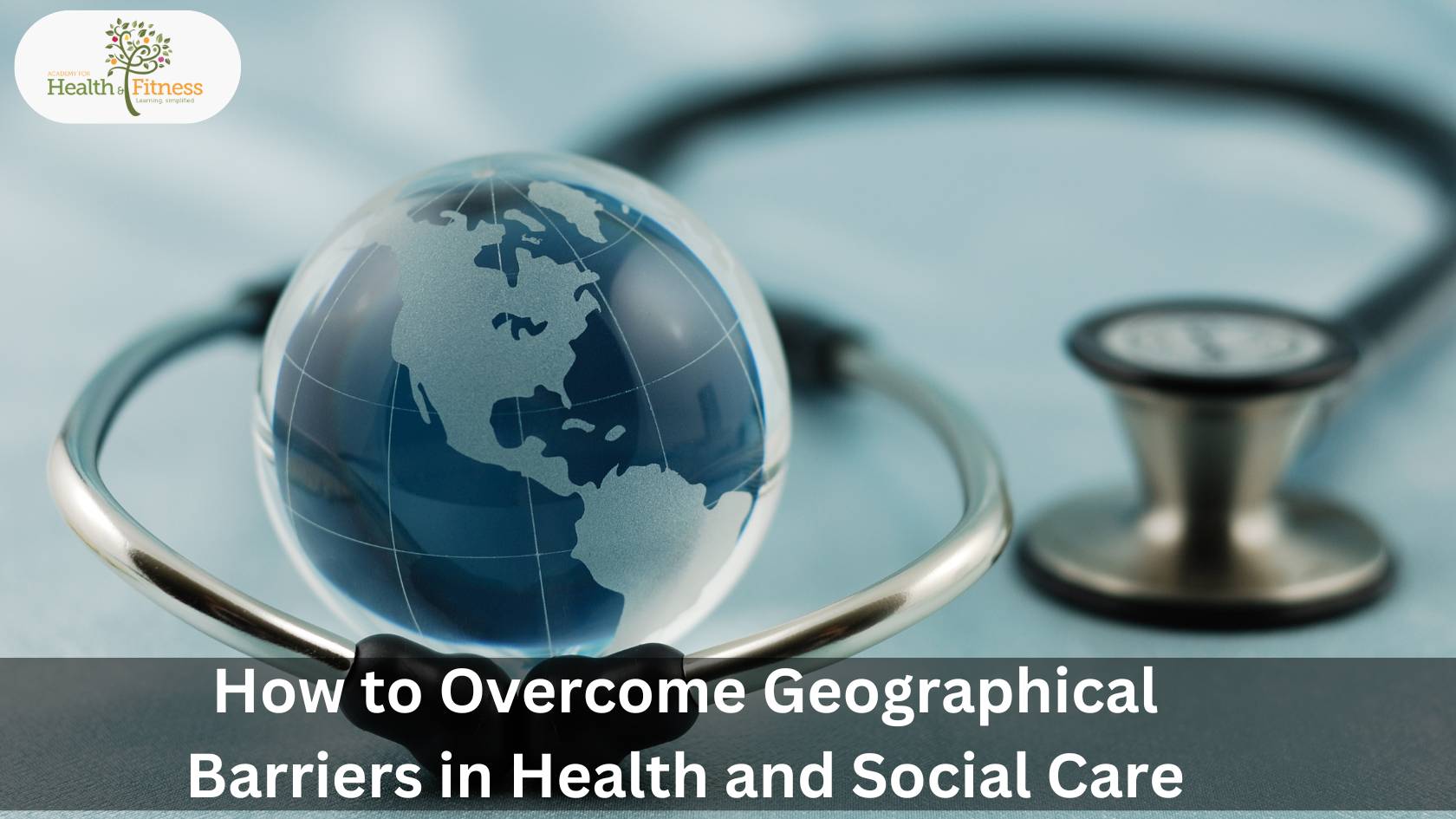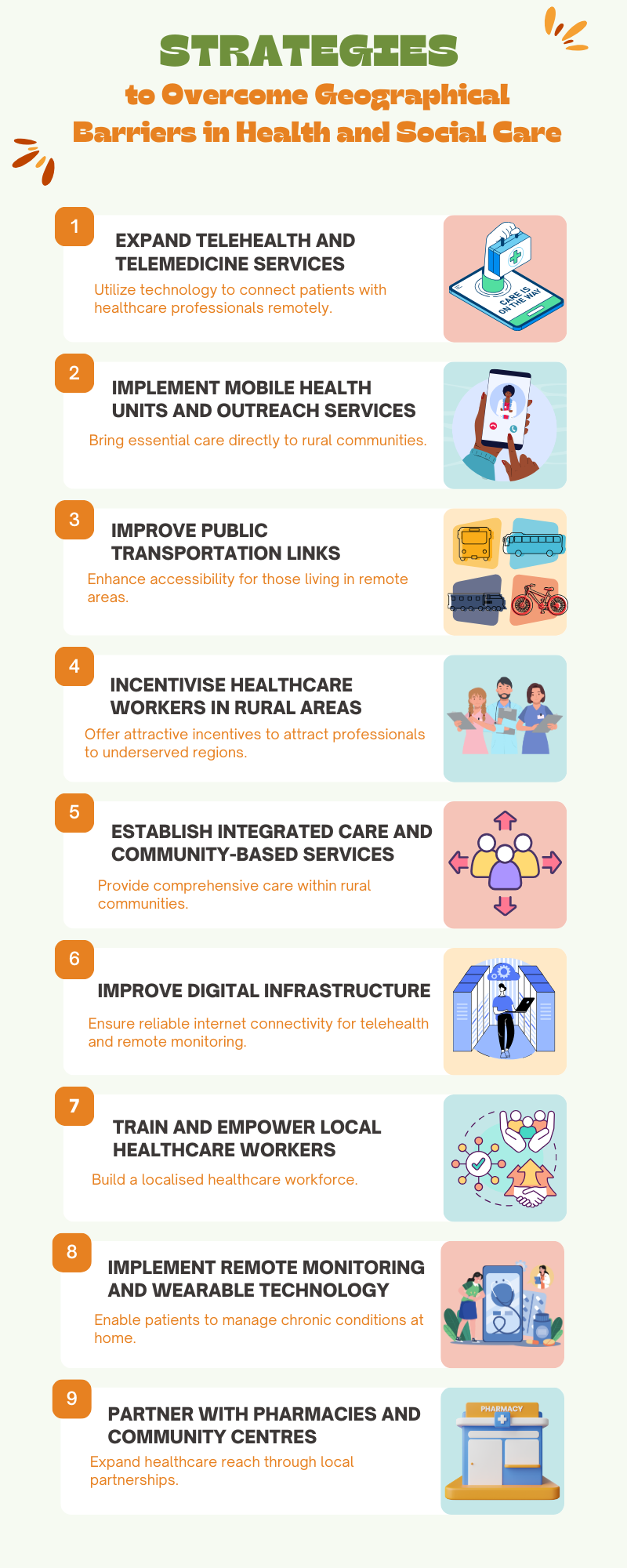
Access to quality health and social care is a fundamental right, but for many individuals, geographical restrictions make it feel out of reach. Whether due to remote locations, restricted transportation, or uneven distribution of healthcare resources, these obstacles frequently result in residents in rural or underserved areas unable to access the necessary care. The effects can be significant, resulting in delayed treatments, worse health outcomes, and increasing gaps between urban and rural areas.
As healthcare systems evolve and the demand for services increases, it is imperative to explore innovative strategies to overcome geographical barriers and ensure equitable access to care for all. In this blog post, we will discuss the challenges posed by geographical barriers, explore potential solutions, and examine the role of technology in bridging the gap.
1. What is a Geographical Barrier in Health and Social Care?
A geographical barrier in health and social care is a physical distance or location-related problem that prevents individuals from receiving the healthcare services they require. These barriers can take various forms, such as living in distant or rural locations far from hospitals or clinics, a lack of speciality treatment nearby, or inadequate transit alternatives that make it difficult to reach healthcare facilities.
For example, someone living in a rural community might have to travel hours to see a doctor or specialist, which can be time-consuming, costly, and even impossible for those without reliable transportation. This can lead to delays in receiving care, missed appointments, or people simply going without the treatment they need.
The basic notion behind a geographical barrier is that where you reside should not influence the kind of care you receive, yet for many individuals, it does. Overcoming these hurdles entails finding methods to bring healthcare closer to people, whether via technology, mobile services, or other innovative solutions that guarantee everyone receives the treatment they need, regardless of where they are.
2. Examples of Geographical Barriers in Health and Social care

Geographical barriers in health and social care refer to obstacles related to the physical location of patients and healthcare services that prevent or limit access to quality care. These barriers often affect people living in rural, remote, or underserved areas and can lead to delays in receiving treatment, higher healthcare costs, and poorer health outcomes. Here are the main geographical barriers in health and social care:
Distance to Healthcare Facilities
People in rural or remote areas often live far from hospitals, clinics, or specialised care centres, making it difficult to access medical services when needed. Long travel times can discourage patients from seeking timely care, leading to worsened health conditions.
Lack of Transportation
In many rural areas, public transportation is limited or nonexistent, leaving people without reliable ways to reach healthcare services. This is especially problematic for the elderly, disabled, or those without access to private vehicles.
Limited Healthcare Infrastructure
Rural or remote areas often have fewer healthcare facilities, limited availability of specialists, and outdated or inadequate medical equipment. This restricts the type and quality of care available, forcing patients to travel to urban centres for more specialised treatments.
Shortage of Healthcare Professionals
Rural and remote areas frequently face a shortage of healthcare workers, including doctors, nurses, and specialists. This shortage can lead to longer waiting times, overburdened medical staff, and lower quality of care.
Reduced Access to Emergency Services
In remote areas, access to emergency services like ambulances or trauma care can be delayed due to the long distances and poor infrastructure. This can have life-threatening consequences in critical situations.
Digital Divide
While telehealth services have helped bridge some gaps, not all rural areas have reliable internet access. The digital divide can prevent people from using telemedicine or online consultations, limiting their access to healthcare professionals.
Financial Barriers Linked to Location
The cost of travelling long distances to healthcare facilities, along with the loss of income due to time spent travelling, can deter people from seeking care. Additionally, rural healthcare may be more expensive due to a lack of competition and fewer resources.
Cultural and Social Isolation
In some rural or remote communities, cultural beliefs or social isolation may prevent individuals from seeking healthcare services. People may prefer local or traditional remedies, mistrust formal healthcare systems, or lack awareness about available services.
3. Strategies to Overcome Geographical Barriers in health and social care

Here are some effective strategies to overcome geographical barriers in health and social care in the UK:
Expanding Telehealth and Telemedicine Services
Telehealth services allow patients in remote areas to access healthcare professionals via video consultations, phone calls, or online platforms. This reduces the need for travel and provides timely access to medical advice and treatment. During the COVID-19 pandemic, the UK saw a significant rise in telehealth usage, proving its potential to bridge geographical gaps. The government and healthcare providers can continue investing in telehealth infrastructure and ensuring rural areas have access to reliable internet services.
Mobile Health Units and Outreach Services
Mobile clinics can bring essential healthcare services directly to rural or underserved communities. These units can provide basic health checks, vaccinations, preventive care, and screenings. The NHS and local councils can deploy mobile health units to areas with limited access to healthcare facilities, ensuring people receive regular check-ups and treatments without the need to travel long distances.
Improving Public Transportation Links
Lack of transportation is a significant barrier in rural areas. Governments can invest in better public transport networks, particularly in remote areas, making it easier for people to reach healthcare services. Subsidised travel schemes or patient transport services can also help ensure that those in isolated areas can access care when needed.
Incentivising Healthcare Workers to Work in Rural Areas
The shortage of healthcare professionals in rural areas can be addressed by offering incentives such as housing allowances, higher pay, or student loan forgiveness programs for doctors, nurses, and other healthcare workers willing to serve in remote regions. The UK government could develop programs similar to this to attract more healthcare professionals to underserved areas.
Integrated Care and Community-Based Services:
Establishing community health centres that offer a range of services, from general practitioner care to specialist consultations, can reduce the need for patients to travel to distant hospitals. The NHS can expand integrated care models where local community health workers and specialists collaborate to provide comprehensive care within rural areas, ensuring that patients receive regular follow-up and personalised treatment.
Improving Digital Infrastructure:
Many rural areas in the UK lack the necessary broadband infrastructure to access telehealth services. Investing in better internet connectivity for rural communities can ensure that more people have access to online consultations, remote monitoring, and health education. Expanding high-speed internet to remote areas is critical for the success of telemedicine and other digital healthcare solutions.
Training and Empowering Local Healthcare Workers:
Empowering community healthcare workers through training programs can help build a localised healthcare workforce. Training local residents as health aides, nurses, or first responders allows them to provide immediate care, reducing the need for patients to travel for minor health concerns. These workers can also serve as a bridge between rural patients and urban healthcare facilities when more specialised care is needed.
Partnerships with Pharmacies and Community Centres
Rural pharmacies and community centres can play a key role in delivering healthcare services, such as health screenings, medication management, and advice on minor illnesses. NHS partnerships with local pharmacies can help extend healthcare reach, making essential services more accessible to people in remote areas.
Implementing Remote Monitoring and Wearable Technology
Remote health monitoring through wearable devices can help patients manage chronic conditions like diabetes, hypertension, and heart disease from their homes. In the UK, initiatives that provide patients in rural areas with health monitoring devices, linked to healthcare providers can ensure that their health is monitored continuously, reducing the need for frequent travel to hospitals.
Government and Policy Support
Policymakers must prioritise rural healthcare by increasing funding for rural health infrastructure, developing rural-specific healthcare policies, and incentivising private healthcare providers to expand services in underserved areas. The NHS could establish rural healthcare hubs or increase investment in smaller local hospitals to ensure that basic and emergency healthcare is always available to rural residents.
4. FAQs
1. What are geographical barriers in health and social care?
Geographical barriers refer to the physical distance or location-related challenges that prevent individuals, particularly in rural or remote areas, from accessing healthcare services. These barriers can include a lack of nearby medical facilities, inadequate transportation, and limited healthcare infrastructure.
2. How can telehealth help to overcome geographical barriers?
Telehealth services, such as video consultations and remote monitoring, can help to bridge the gap between patients and healthcare providers in rural areas. By reducing the need for travel, telehealth can improve access to care and reduce costs.
3. What role can community-based healthcare services play in addressing geographical barriers?
Community-based healthcare services, such as mobile clinics and community health centres, can bring essential healthcare services directly to rural communities. This can help to reduce the need for patients to travel long distances for care.
4. Why is improving transportation links important for overcoming geographical barriers in healthcare?
Better transportation links are essential for individuals in rural areas to access healthcare services. By investing in public transportation networks and patient transport services, governments can ensure that even isolated communities can reach hospitals and clinics when needed.
5. What are the long-term benefits of overcoming geographical barriers in health and social care?
Overcoming geographical barriers can lead to improved health outcomes for individuals living in rural areas, reduced health disparities, and a more equitable healthcare system overall.
5. Final Words
Overcoming geographical barriers in health and social care is not just a logistical challenge—it’s a matter of equity and human rights. Every individual, regardless of where they live, deserves access to quality healthcare. By focusing on digital infrastructure, incentivising healthcare professionals to work in remote regions, and enhancing community-based care, the UK can ensure that no one is left behind in the healthcare system.
The journey towards overcoming these barriers requires collective effort, from government support to community involvement, to create a future where healthcare is truly accessible to all. It’s not just about closing the distance between people and services; it’s about bringing care, compassion, and health equality to everyone, no matter where they call home. Now is the time to take action and ensure that geographical barriers are a thing of the past.